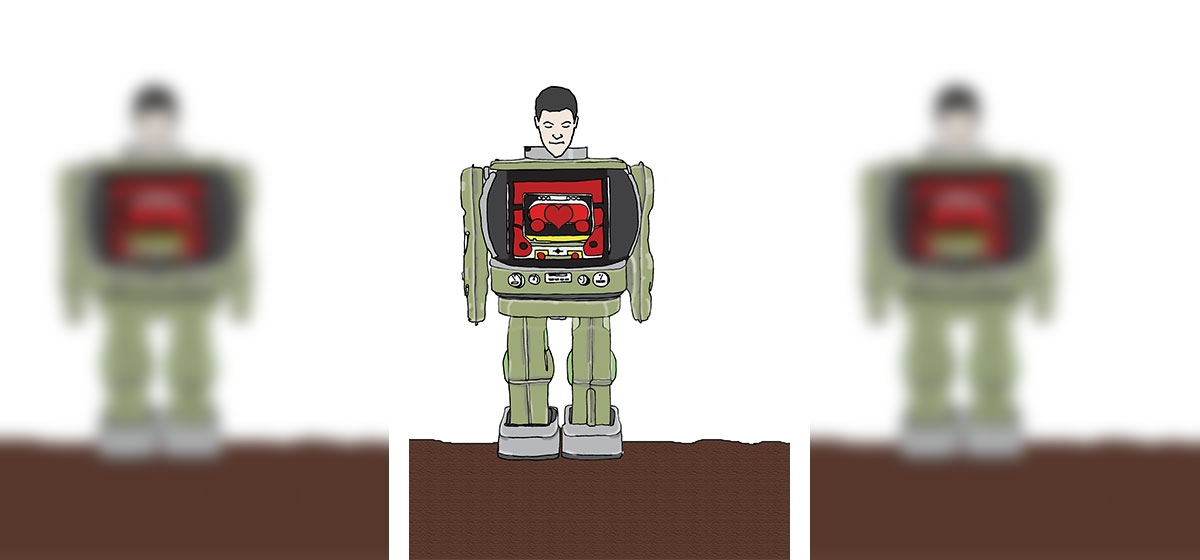
Who says you can’t make a silk purse out of a sow’s ear?! In his new book, “Almost Human: Making Robots Think,” Lee Gutkind, the guru of creative nonfiction, does just that; using his literary skills to transform prosaic material about machines into an exuberant celebration of human creativity.
Not that the topic isn’t interesting. Robotics is widely acknowledged as the next hot thing in the technological world, having grown in just a few decades from a minor subsidiary of computer science into a full-fledged, cutting-edge industry poised to transform modern life.
However, the robots under development at Carnegie Mellon University’s Robotics Institute, where the author spent six years as a fly on the wall, are neither the thrilling humanoids of cinema nor the much-anticipated, smart, mobile, niche products programmed to perform labor-saving tasks. They are by and large hard-working, decidedly unglamorous devices “for the possibility of tomorrow rather than the reality of today,” intended mainly for mine mapping, space exploration and unspecified military applications. Progress is made subtly and incrementally, and the dramatic tension, such as it is, is largely intellectual. Also, the action is decidedly limited. Waiting, watching, googling and rebooting are the principal activities in a field where “nothing works the first time and very often nothing works the first hundred times.”
In the wrong hands, this material might prove excruciatingly dull, but to Gutkind the process of making robots think is an art form — a mixture of “substance and outlandish ideas and improvisation, similar to jazz” — and he treats it as such, using his brand of narrative journalism to give it literary life. The book opens with a “bumping, swerving, back-breaking, jaw-crunching” jeep ride representing the bumpy road to robot autonomy, and continues at a clip through successes and setbacks. Matching his technique to his subject, the author travels like the rovers he profiles across the field of robotics, pausing to examine numerous and varied specimens of interest, and transmitting “images” of his findings to the reader. Focus continually shifts between lab and field operations, and scores of vivid characters — both human and robotic — populate the adventure.
Indeed it is Zoe, the robotic astrobiologist, developed for use on Mars, that is the real star of “Almost Human.” Although “she” lacks the silky curls and soulful eyes of a conventional heroine (bearing a closer resemblance to a go-cart or a flatbed railroad car), her trial-and-error misadventures read like the “Perils of Pauline.” Overcoming challenging terrain, software glitches, accidents and alterations, she alone among the robots profiled succeeds in performing autonomously and against all odds; detecting signs of life in the Chilean desert without human intervention even as she herself begins to break down:
“Zoe, that magnificent but fragile mechanical marvel, will begin to disintegrate as … the wear and tear … and sometimes slipshod treatment it received begin to take their toll…. Zoe, limping and struggling, will perform autonomous science at least one more time before the end of the third [field experiment].”
The issue of autonomy is what distinguishes the developmental robots at CMU from their commercial counterparts. Such devices — like those used on assembly lines — are programmed for specific tasks in fairly predictable environments and often work alongside humans as “cobots.” But Zoe and her cousins Groundhog, Sandstorm and H1ghlander must operate alone in areas inaccessible or hazardous to human beings. The challenge, therefore, is getting them to behave as a human would. In this respect, the objective is much the same as child-rearing.
While a parent may control a child’s behavior by nagging, pleading, and/or shouting to see that beds are made and homework completed (the robotic equivalent of which is teleoperating or “joysticking”), the ultimate goal is an individual who completes these tasks independently and, ideally, initiates other similar activities (e.g. carrying the basket of laundry on the stairs up the stairs, rather than passing it repeatedly because removing it is not one of the child’s “programmed” chores).
Although roboticists are spared impudent backtalk, their job is infinitely more difficult than a parent’s. Robots lack the evolutionary advantages of human beings and possess no natural instincts, emotions or motivations (eliminating those pillars of parenting — bribery and guilt — as techniques for training). Therefore they must be programmed with a vast portfolio of options from which to choose in any given situation and equipped with sophisticated hardware to allow them to respond rapidly and precisely to the option selected. In addition, hardware routinely breaks down, software goes haywire, funding collapses and simple, old-fashioned misunderstandings produce crippling communication disconnects.
Because robotics is associated in the popular mind with futuristic fail-safe accuracy, it is astonishing and rather quaint to discover that progress may stall over semantics. In the chapters “Two Versions of Reality” and “Hardware vs. Software,” the author describes scientists and engineers debating the definition of terms as fundamental to their work as “autonomy,” “intelligence” and “cognition.” In one particularly absurd example, parties discussing a lot of white rocks are unable to agree on the definitions of “a lot” and “white.” One is reminded of the biblical confusion of tongues, sent to limit human achievement: “How,” wonders one observer, “are we ever going to get the scientists to tell the engineers what they need, so the engineers can build the right system, if the scientists can’t agree on … surprisingly basic levels?”
The question is rhetorical, of course, for no one in “Almost Human” doubts the ability of robotics to prevail, least of all the three central human characters. Most striking among these is the manic, charismatic Red Whittaker, a fixture at the institute since its founding in 1979. The Svengali of robotics, Whittaker is perpetually on the outlook for “fresh blood” in the form of eager, naïve techies willing to work endlessly under difficult circumstances to help him realize his schemes. His “killer competitive instincts” and larger-than-life personality are reflected in the souped-up robotic Humvees designed to ride roughshod over the competition in an off-road race toward a million-dollar prize.
Contrasted to Whittaker is mild-mannered David Wettergreen, a “walking, talking statement on behalf of the nondescript” who nevertheless wields “tremendous moral authority” over his team. More patient and practical than Whittaker, but no less visionary, Wettergreen is so consumed with his efforts to expand the frontiers of knowledge that he spares only one morning a week to the task of shaving his beard.
Falling between the two extremes is the effusive optimist Manuela Veloso, one of the few women prominent in her field and organizer of the international RoboCup soccer competition. She is quick to make a distinction between robots and machines but hesitates when distinguishing between robots and humans. “We don’t really know if we are creatures of God or DNA,” she tells Gutkind. “There are people that believe that we have a conscience and a soul and others who believe we are just matter. And if we are just matter, then probably robots are just like we are.”
Complementing this cast is a chorus of seemingly interchangeable sleep-deprived students; troubleshooting twentysomethings who provide “the brawn and much of the brains” at the Robotics Institute. They are the foot soldiers of the so-called Rookie Revolution; a generation raised on computers who aspire to change the world. They are also the true artists in Gutkind’s portrait of technical creativity. Their imaginations and ingenuity flourish in the chaotic nursery-style atmosphere of the R.I., where they fiddle with robots like “giant Legos,” and generate “off-the-wall ideas and concepts that mature programmers and engineers might never attempt or commit themselves to.” Like all true artists, they suffer for their art, and gladly. “It’s the frustration that keeps me going,” remarks one student, “…I love the pain, because when you have a breakthrough, when something works, it is such a rush.”
Ultimately it is this, “the fascination of creating something, no matter how long it takes,” that is the essence of the book. “Almost Human” is less about robots than it is about the universal aspects of the creative process. The careful plans and unforeseen disasters; the blocks and the breakthroughs; the sudden flashes of inspiration and persistent misunderstandings; the energy and anarchy of improvisation and constraints of funding; the stultifying boredom of delays and the excitement of serendipitous discoveries (such as the one gleefully detailed in “Peeing on Rocks”). These are characteristics of all creative human endeavors; no more or less so in robotics than in writing, painting, music and parenting. By positioning robotics at the nexus of technology and the liberal arts, Gutkind splendidly renders robotics … almost humanistic.





